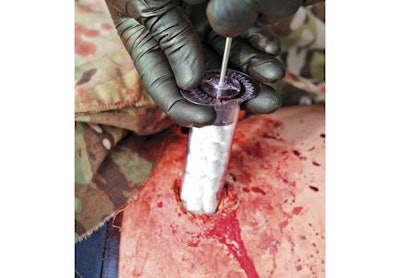 Injecting XSTAT's large syringe of sponges into a severe wound stops hemorrhaging within 15 to 20 seconds. (Photo: RevMedx)
Injecting XSTAT's large syringe of sponges into a severe wound stops hemorrhaging within 15 to 20 seconds. (Photo: RevMedx)
Every day on duty you're walking into harm's way, and anything could happen. What if you sustain an injury so severe that you're in danger of bleeding out and a standard tourniquet won't help? Now there is a product designed to treat such a wound and stop excessive bleeding in seconds. And it's been cleared for law enforcement use.
RevMedx developed XSTAT in conjunction with U.S. Military Special Forces to address the problem of junctional hemorrhage. That's bleeding where a limb meets the body and using a tourniquet is difficult. Traditional treatment would entail packing the wound with as much gauze as possible, but some injuries are so severe that there is not enough time to create enough pressure and stop the bleeding this way. The other option is a junctional tourniquet, but it can be expensive, bulky, and difficult to use properly.
XSTAT works differently. The applicator is essentially a large syringe preloaded with 92 round compressed, mini surgical-grade sponges treated with chitosan. You push the applicator as far as possible into the wound and press in the plunger to inject the contents. Within 15 to 20 seconds, the sponges expand in length and fill the wound, putting pressure exactly where it's needed and stopping the bleeding.
"XSTAT is the only hemostatic product of this category cleared for internal use before you get to the hospital," says Will Fox, vice president of sales and marketing for RevMedx. "The applicator is designed to be inserted into the wound as far as possible because that's how it's most effective.
"It's kind of gross, but these aren't your typical accidents," says Fox. He says for crushed limbs, blast injuries, or gunshot wounds next to where body armor coverage stops, XSTAT is the best way to stop bleeding. Right now XSTAT is only cleared for use in junctional wounds in the inguinal (groin) areas and axilla area.
The sponges may remain in the body for up to four hours before being removed surgically. Anyone suffering such a severe injury will need to undergo surgery, and it is standard practice to look for any remaining surgical sponges or other tools on an X-ray and remove them before closing up a wound. The XSTAT sponges contain a radiopaque marker so that they also can be found on an X-ray for easy removal.
XSTAT comes in a sterile foil package containing one or three filled applicators. The three-pack is intended only for very severe blast injuries. Once the package is opened, any included applicators must be discarded whether used or not. But obtaining these packages currently requires a prescription.
"Most SWAT teams are associated with a medic or physician that is responsible for the training of the officers on the SWAT team. If so, they can purchase XSTAT and administer it under the guidance of the physician," says Fox.
Until relatively recently, tourniquets were seen as specialized equipment and few in law enforcement carried or used them. Now, it's common for patrol officers to keep them on hand during every shift. Fox expects XSTAT to follow the same trend and be there to help more first responders when they need it for traumatic injuries.
"We've been manufacturing this product for less than 12 months and we have had a confirmation from the Army that it did save a life," says Fox. "This is very exciting because our main mission with XSTAT and all of our products is to save lives."


















